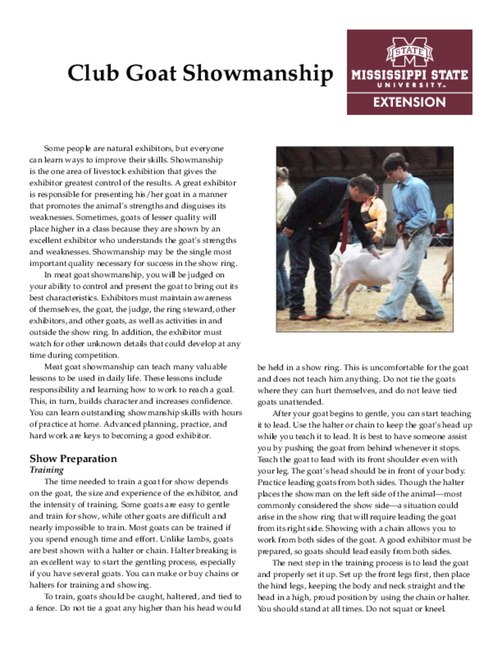Club Goat Showmanship
Some people are natural exhibitors, but everyone can learn ways to improve their skills. Showmanship is the one area of livestock exhibition that gives the exhibitor greatest control of the results. A great exhibitor is responsible for presenting his/her goat in a manner that promotes the animal’s strengths and disguises its weaknesses. Sometimes, goats of lesser quality will place higher in a class because they are shown by an excellent exhibitor who understands the goat’s strengths and weaknesses. Showmanship may be the single most important quality necessary for success in the show ring.
In meat goat showmanship, you will be judged on your ability to control and present the goat to bring out its best characteristics. Exhibitors must maintain awareness of themselves, the goat, the judge, the ring steward, other exhibitors, and other goats, as well as activities in and outside the show ring. In addition, the exhibitor must watch for other unknown details that could develop at any time during competition.
Meat goat showmanship can teach many valuable lessons to be used in daily life. These lessons include responsibility and learning how to work to reach a goal. This, in turn, builds character and increases confidence. You can learn outstanding showmanship skills with hours of practice at home. Advanced planning, practice, and hard work are keys to becoming a good exhibitor.
Show Preparation
Training
The time needed to train a goat for show depends on the goat, the size and experience of the exhibitor, and the intensity of training. Some goats are easy to gentle and train for show, while other goats are difficult and nearly impossible to train. Most goats can be trained if you spend enough time and effort. Unlike lambs, goats are best shown with a halter or chain. Halter breaking is an excellent way to start the gentling process, especially if you have several goats. You can make or buy chains or halters for training and showing.
To train, goats should be caught, haltered, and tied to a fence. Do not tie a goat any higher than his head would be held in a show ring. This is uncomfortable for the goat and does not teach him anything. Do not tie the goats where they can hurt themselves, and do not leave tied goats unattended.
After your goat begins to gentle, you can start teaching it to lead. Use the halter or chain to keep the goat’s head up while you teach it to lead. It is best to have someone assist you by pushing the goat from behind whenever it stops. Teach the goat to lead with its front shoulder even with your leg. The goat’s head should be in front of your body. Practice leading goats from both sides. Though the halter places the showman on the left side of the animal—most commonly considered the show side—a situation could arise in the show ring that will require leading the goat from its right side. Showing with a chain allows you to work from both sides of the goat. A good exhibitor must be prepared, so goats should lead easily from both sides.
The next step in the training process is to lead the goat and properly set it up. Set up the front legs first, then place the hind legs, keeping the body and neck straight and the head in a high, proud position by using the chain or halter. You should stand at all times. Do not squat or kneel.
After lead training is complete, you should practice showing. Set up your goat and show it while someone else handles it. You must make sure the goat looks good at all times. Mounting a mirror in the barn will allow the exhibitor to see how the goat looks when set and have a better understanding of positioning. If the goat responds properly, return it to the pen and do not overwork it. During hot weather, work goats early in the morning or late in the evening to avoid heat stress on both you and the goat. The more time you spend training goats, the more successful your experience will be when you and the goats enter the show ring. Remember, in a major show, you may have only a short time to actually show your goat. If the goat does not show properly when the judge handles it, you may get overlooked.
Appropriate Dress
Dress neatly and professionally for the show. Leather boots are preferred for safety and appearance. Wear clean jeans or slacks and shirt. Tuck your shirt in and wear a belt. You should be neat in appearance but not overdressed. Do not wear a hat or cap in the show ring. Proper planning and nice appearance will make a positive impression on the judge.
Show Time
Your planning, selection, feeding, fitting, training, and grooming all pay off in the show ring. Your skill in exhibiting your goat cannot be emphasized enough. It is often the difference between winning and losing. You must be mentally and physically ready to enter the show ring for competition. By completing the preparation activities, you should have confidence that you can do an effective job showing your goat.
Before the show, walk over the ring to find the high and low spots on the arena surface. This will help you get the goat set up with its front end uphill rather than in a hole. By setting the goat’s front feet uphill, you will give the appearance of an extended front end and a longer-patterned animal.
When the show begins, watch the judge to see how he works the goats. You will feel more comfortable and confident if you know what the judge will want you to do. Be mentally prepared to answer questions and handle anything unexpected, as well.
In the Ring
When the appropriate class is called, take your goat to the show ring. Be sure to enter the show ring promptly, leading your goat from the left-hand side. As the ring steward lines up the goats, set your goat to look its best. Avoid corners of the ring, and leave plenty of space between your goat and others. Quickly, yet smoothly, set the goat up so all four feet are at the corners of the body and the weight is distributed evenly to all four legs (Figure 1). Keep the body, neck, and head in a straight line with the head up and alert. If you are in a large class, allow your goat to relax when the judge is not evaluating it. Overworking or constantly resetting a goat’s feet may lead to an aggravated, uncooperative goat.
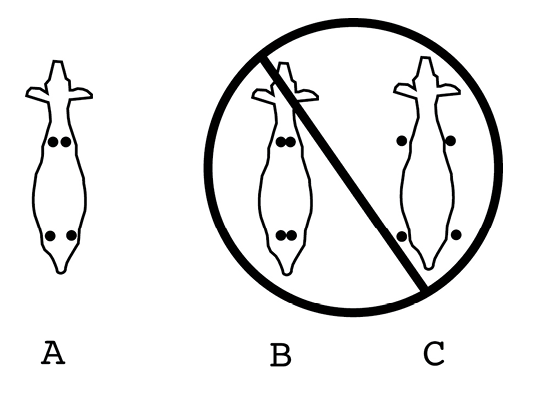
Never place your hand on the goat’s back or the base of the neck, because this will hide the judge’s view of the goat’s top. To set up, face the goat with your body and hold the head up with your right hand on the collar or lead and your left hand over the head and underneath the jaw. (Be prepared to work with either hand on the collar and either leg in front of the goat in order to stay on the opposite side of the goat from the judge at all times.) Place your leg in front of the goat, and stay in front while the judge is viewing the goat from the rear. As the judge moves around the right side and to the front of the goat, remain on the left side. Then face the judge and step to the side to provide a front view of the goat (Figure 2).
When the judge walks around in front of the goat to get a front-view and evaluate structural correctness and muscling through the front end of the goat, stand beside the shoulder opposite of the judge and face the same direction as the goat. Move slowly when working around the front end of the goat, staying on the opposite side of the goat from the judge. Correctly place the goat’s front feet so it does not stand too wide or narrow; hold the goat’s head so a straight line could be drawn from nose to tail. Do not step away from the animal because you will lose some control over the goat, and your movement tends to pull the goat’s head out of proper alignment with its body. Hold the goat’s head high as the judge analyzes it. As the judge moves to the left side of the goat, move back to the opposite side of the goat to give the judge a full view of the entire animal.
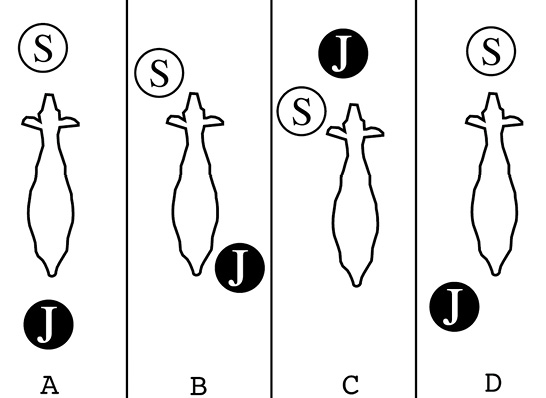
When in a lineup of goats, the showman may be asked to switch positions with another goat in the lineup, or the goat may need to be positioned again in the same spot. Figures 3a–d illustrate the proper movement of goats in this manner. In Figure 3a, the showman is asked to move their goat from position 4 to position 2 in the lineup. In this situation, the showman should lead the goat forward, turn it to the right, lead the goat back through position 4, lead the goat to the right, and then enter position 2 to reset their goat. In Figure 3b, the showman in position 3 needs to reset their goat in the same position. This could be due to another goat encroaching on the space of the goat in position 3, or the showman’s goat not being cooperative. In either instance, the showman should lead the goat out of position 3, turn the goat right to lead the goat back through position 3, turn the goat to the right again, and lead it back into position 3 to be reset. The next scenario (Figure 3c) illustrates the showman switching from position 2 to position 7 in the lineup. The showman should lead the goat forward from position 2, turn it to the right to cross through the same position, then lead the goat to the left into position 7. The final scenario (Figure 3d) demonstrates the switching of two showmen in positions 4 and 5. The goat in position 5 (depicted with the smaller dash marks) would lead their goat our first, turn it to the right and cross back through position 5, then turn the goat to their right and enter position 4. To make room for the arriving goat, the showman in position 4 should lead their goat out after the showman who started in position 5 has crossed back through position 5. Then the showman who started in position 4 can cross through position 5, turn their goat to the right, and set up their goat in position 5. While other positions could be switched, these four examples illustrate the proper technique the showman should use when switching positions with their goat in a lineup.
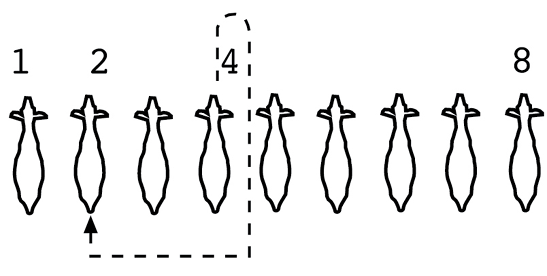

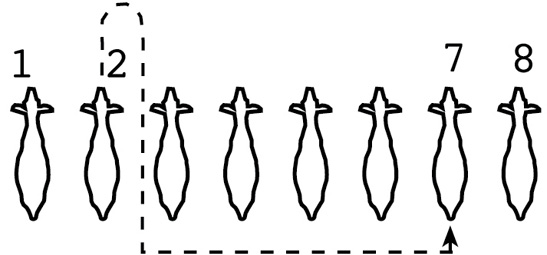
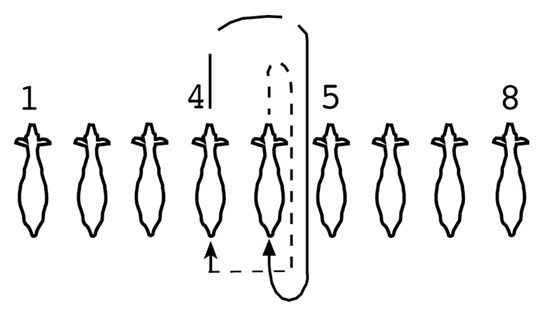
Handling the Goat
If the judge comes in to handle the goat, be prepared with your leg in front of the goat to keep it from jumping forward, and hold the head straight in line. In order to be competitive in any given situation, goats must be taught to brace. Since competitive goats do not get over 115 pounds, bracing has become a relatively easy technique for smaller exhibitors to master. It provides the most level playing field when showing against bigger, stronger exhibitors.
Do not brace the goat as you would a lamb. Front feet should remain on the ground with the front end of the goat extended fully. “Driving” the goat like a lamb will only tend to make the goat slope at the hip and less desirable in appearance. Goats do not require the same amount of brace seen in the lamb show ring. However, a small amount of pressure applied correctly to the front of the goat will make the animal feel much better than his counterparts that are not braced. Do not be surprised to see the animals that are braced stand at the top of the class. To be competitive, train your goat to brace and stand in place with all feet on the ground.
As a good exhibitor, you must be alert and know where the judge is at all times. Remain calm and concentrate on showing. Set up your goat and be ready before the judge gets to you. Be careful not to cover your goat with your body and block the judge’s view. Always keep your goat between you and the judge. Remember, in large classes, it may take some time before the judge handles your goat. Be patient and let your goat relax.
Finishing the Class
After handling your goat, the judge usually will step back and look at it. Be sure to keep the goat’s head up and its body, neck, and head in a straight line. Watch the judge and your goat. It is your responsibility to pay attention to the judge and not miss a decision. At this point, the judge will usually walk the goats and set them up on the profile. Set your goat up as discussed before.
Continue to keep it set up, remain alert, and watch the judge. If your goat is not pulled the first time, keep trying. Some judges will pull exhibitors from bottom to top. If your goat is pulled, circle it out of the line and follow the directions of the ring steward while continuing to keep an eye on the judge. Move your goat with style and at a steady, moderate pace. Remember to keep showing at all times, because a class is not over until the ribbons are given out. Be courteous to fellow exhibitors. Remain standing at all times, and always have a pleasant facial expression. Be a good sport, a graceful loser, and a humble winner.
Publication 2263 (POD-05-21)
Reviewed by Dean Jousan, PhD, Associate Extension Professor, Animal and Dairy Sciences. Written by R. Kipp Brown, retired Extension Associate, Animal and Dairy Sciences. Adapted from Publication ANS96-603S/6, North Carolina Extension Service and Publication AS3-4.060, Texas Agricultural Extension Service.
